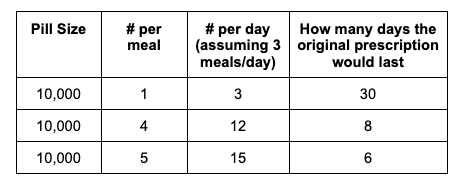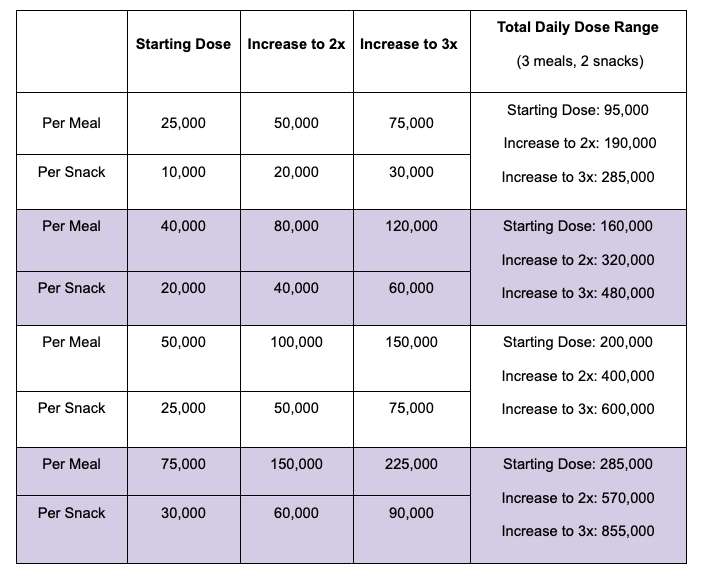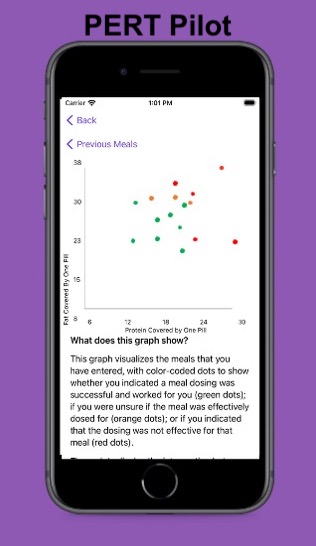In exocrine pancreatic insufficiency (EPI/PEI/PI), people are responsible for self-dosing their medication every time they eat something.
Doctors prescribe a starting dose, but a person with EPI determines each and every time they eat or drink something how many enzyme pills (of pancreatic enzyme replacement therapy, known as PERT) to take. Doctors often prescribe a low starting dose, and people have to try experimenting with multiple pills of the small size, and eventually work with their doctors to change their prescription to get a bigger pill size (so they can take fewer pills per meal) and the correct number of pills per day to match their needs.
For example, often people are prescribed one 10,000 unit pill per meal. The 10,000 units represents the amount of lipase (to help digest fat). There are also two other enzymes (protease, for protein digestion, and amylase, for carbohydrate digestion). They may be prescribed 1 pill per meal, which means 10,000 units of lipase per meal. But most dosing guidelines recommend starting at a dose of 40,000-50,000 units of lipase per meal (and people often need more), so it wouldn’t be surprising that someone prescribed one 10,000 pill per meal would need 4-5 pills of the 10,000 size pill PER MEAL, and times three meals per day (let alone any snacks), to get acceptable GI outcomes.
Mathematically, this means the initial prescription wouldn’t last long. The initial prescription for 1 pill per meal, with 3 meals a day, means 3 pills per day. 3 pills per day across a 30 day month is 90 pills. But when the pills per meal increase, that means the prescription won’t cover the entire month.
In fact, it would last a lot less than a month; closer to one week!

Let’s repeat: with a too-small prescription pill size (e.g. 10,000 starting dose size) and count (e.g. 3 pills per day to cover 1 per meal) and with a person with EPI titrating themselves up to the starting dose guidelines in all of the medical literature, they would run out of their prescription WITHIN ONE WEEK.
So. If you have EPI, you need to be prepared to adjust your dosing yourself; but you also need to be ready to reach out to your doctor and talk about your need for more enzymes and a changed prescription.
PERT (enzymes) come in different sizes, so one option is to ask for a bigger pill size and/or a different amount (count) per meal/day. Depending on the brand and the number of pills you need per meal, it could be simply going up to a bigger pill size. For example, if you need 3 pills of the 10,000 PERT size, you could move to a 36,000 pill size and take one per meal. If you find yourself taking 5 pills of the 10,000 PERT size, that might mean 2 pills of the 25,000 size. (Brands differ slightly, e.g. one might be 24,000 instead of 25,000, so the math may work out slightly differently depending on which brand you’re taking.)
Don’t be surprised if you need to do this within a week or two of starting PERT. In fact, based on the math above, especially if you’re on a much lower dose than starting guidelines (e.g. 40,000-50,000 units of lipase per meal), you should expect within a few days to need an updated prescription to make sure that you don’t run out of PERT.
If you do find yourself running out of PERT before you can get your prescription updated, there is an alternative you can consider: either substituting or adding on over the counter enzymes. The downsides include the fact that insurance doesn’t cover them so you would be paying out of pocket; plus there are no studies with these so you can’t (shouldn’t) rely on these as full 1:1 substitutes for prescription PERT without careful personal testing that you can do so. That being said, there is anecdotal evidence (from me, as well as hundreds of other people I’ve seen in community groups) that it is possible to use OTC enzymes if you can’t afford or can’t get a PERT prescription; or if you need to “top off”/supplement/add to your PERT because your prescription won’t last a full month and you can’t get a hold of your doctor or they won’t update your prescription.
For me, I generally evaluate the units of lipase (e.g. this kind is 17,000 units of lipase per pill) but then factor in for the lack of reliability for OTC and really treat it like it contains 13-15,000 units of lipase when choosing to take it. Similarly for another lipase-only OTC option (that has ~6,000 units per pill), I assume it acts like it only has ~5,000 units. Unlike insulin, there is little downside to taking a little too much of enzymes; but there is a LOT of downside to not taking enough, so my personal approach is that if in doubt, or on the fence, to round up (especially with OTC pills, which cost somewhere between $0.08/pill (lipase-only) to $0.34/pill (for the larger and multiple enzyme pill)).
So how do you talk to your doctor about needing more PERT?
It helps if you bring data and evidence to the conversation, especially if your doctor thinks by default that you don’t need more than what they initially prescribed. You can bring your personal data (more on that below and how to collect and present that), but you can also cite relevant medical literature to show if your dose is below standard starting guidelines.
Below I’ve shared a series of citations that show that the typical starting dose for people with EPI should be around 40,000-50,000 units of lipase per meal.
Important note that this is the STARTING DOSE SIZE, and most of these recommend further increasing of dose to 2-3 times this amount as needed. Depending on the starting dose size, you can see the chart I built below that illustrates with examples exactly how much this means one might need to increase to. Not everyone will need the upper end of the numbers, but if a doctor starts someone on 10,000 and doesn’t want to get them up to 40,000 (the lower end of starting doses) or go beyond 40,000 because it’s the starting dose, I’ve found this chart useful to show that numerically the range is a lot larger than we might assume.
Example of Titrating According to Common Dose Guidelines, Before Adding PPI

Here are some citations that back up my point about 40,000-50,000 units of lipase being the typically recommended starting dose, including across different conditions (e.g. regardless of whether you have EPI + any of (chronic pancreatitis, diabetes, celiac, etc)).
- Shandro et al, 2020, the median starting dose of 50,000 units per lipase “is an appropriate starting dose”, also citing UEG 2017 guidelines.
- Forsmark et al, 2020, defined appropriate dose of PERT as >=120,000 units of lipase per day (e.g. 40,000 units of lipase per meal).
- Whitcomb et al, 2022, in a joint American Gastroenterology Association and PancreasFest symposium paper, concur on 40,000 units as a starting dose and that “This dose should be titrated up as needed to reduce steatorrhea or gastrointestinal symptoms of maldigestion “
- 2021 UK guidelines for EPI management suggest 50,000 units as the starting dose and emphasize that “all guidelines endorse dose escalation if the initial dose is not effective”
There are also many guidelines and research specific for EPI and different co-conditions supporting the ballpark of 40-50,000 units of lipase starting dose:
- chronic pancreatitis and EPI (2017 HanPanEU guidelines; 2018 United European Gastroenterology (UEG) guidelines; 2020 American College of Gastroenterology (ACG) guidelines)
- pancreatic cancer and EPI (2011 “Practice of Pancreatic Enzyme Replacement Therapy in Patients With Exocrine Insufficiency; A North European Survey “; 2017 “The Role of Pancreatic Enzyme Replacement Therapy in Unresectable Pancreatic Cancer: A Prospective Cohort Study”; 2021 “Diagnosis and Management of Pancreatic Exocrine Insufficiency in Pancreatic Cancer”). Note that several pancreatic cancer studies and papers also suggest a higher dose may be needed than in many other co-conditions, e.g. a 2018 study found a median dose of 325,000 units of lipase per day (120,000 would be 40,000 units/meal) increased survival rate, even though the starting dose was 50,000.
- diabetes and EPI (Radlinger et al 2020, Cummings et al 2015)
- (If you’re looking for a particular co-condition, feel free to email me (Dana@OpenAPS.org) and I’m happy to help find the most up to date research (if there is any)).
It is also worth noting that these guidelines also point out that after titrating 2-3x above the starting dose, PPI (proton pump inhibitors, to suppress acid) should be added if gastrointestinal symptoms are still not resolved. Anecdotally, it seems a lot of doctors are not aware that PPIs should be added if 3x the starting dose is not effective, so make sure to bring this up as well.
How to Share Your Personal PERT Data To Show How Much You Need
In addition to pointing out the guidelines (based on the above), it’s useful to share your data to show what you’ve been taking (dosing) and how it’s been working. I’ve written a lot about how you can do this manually, but I also recently created an iOS based app to make it easier to track what you’re eating, what you’re dosing in terms of PERT/enzymes, and what the outcome is. This app, PERT Pilot (iOS, or see Android version here), is free to use, and it also enables you to visualize on a graph the relationship between what you’re eating and dosing.
PERT Pilot lets you track how many grams of fat each pill of your current prescription has been used for, so you can see with red and green coloring the relationship between meals that you’ve had symptoms after (in red) vs. when you recorded no symptoms (green). If you have a “convergence zone” of green and red in the same area, that may help you decide to change your ratio (e.g. dose more) around that amount, until you can comfortably and repeatedly get green results (no symptoms when you eat).
How you might use this to talk to your doctor
You can take a screenshot of your PERT Pilot graph and share it with your doctor to show them how many grams of fat your prescription size (e.g. pill size) effectively “covers” for you, and how many meals that you’ve tested it with.
 For example, I was initially prescribed an enzyme dose that was one pill per meal (and no snacks), so I had 3 pills per day. But I quickly found myself needing two pills per meal, based on what I was typically eating. I summarized my data to my doctor, saying that I found one pill typically covered up to ~30 grams of fat per meal, but most of my meals were >30 grams of fat, so that I wanted to update my prescription to have an average of 2 pills per meal of this prescription size. I also wanted to be able to eat snacks, so I asked for 2 pills per meal, 1 per snack, which meant that my prescription increased to 8 pills per day (of the same size), to cover 2 pills x 3 meals a day (=6) plus up to 2 snacks (=2). I also had weeks of data to show that my average meal was >30 grams of fat to confirm that I need more than the amount of lipase I was originally prescribed. My doctor was happy to increase my prescription as a result, and this is what I’ve been using successfully for over a year ever since.
For example, I was initially prescribed an enzyme dose that was one pill per meal (and no snacks), so I had 3 pills per day. But I quickly found myself needing two pills per meal, based on what I was typically eating. I summarized my data to my doctor, saying that I found one pill typically covered up to ~30 grams of fat per meal, but most of my meals were >30 grams of fat, so that I wanted to update my prescription to have an average of 2 pills per meal of this prescription size. I also wanted to be able to eat snacks, so I asked for 2 pills per meal, 1 per snack, which meant that my prescription increased to 8 pills per day (of the same size), to cover 2 pills x 3 meals a day (=6) plus up to 2 snacks (=2). I also had weeks of data to show that my average meal was >30 grams of fat to confirm that I need more than the amount of lipase I was originally prescribed. My doctor was happy to increase my prescription as a result, and this is what I’ve been using successfully for over a year ever since.
So in summary, the data that would be useful to share is:
- How much one pill ‘covers’ (which is where the PERT Pilot graph can be used)
- How many pills per meal you’ve been taking and how big your meals typically are
- Whether you are struggling with the number of pills per meal: if so, ask whether there’s a larger pill size in your current brand that you could increase to, in order to reduce the number of pills per meal (and/or snack) you need to take every time
If you are told that you shouldn’t need “that much”, remember the above section and have those resources ready to discuss that the starting dose is often 40,000-50,000 per meal and that the guidelines say to titrate up to 3x that before adding PPI. Therefore, it would be expected for some people to need upwards of 600,000 units of lipase per day (50,000 starting dose, increased 3x per meal and half of the dose used per snack). Depending on what people eat, this could be even higher (because not everyone eats the same size meal and snack and many of us adjust dose based on what we eat).
Also, it is worth noting that the dosing guidelines never mention the elastase levels or severity of EPI: so PERT prescriptions should not be based on whether you have “moderate” or “severe” EPI and what your elastase level is (e.g. whether it’s 45 or 102 or 146 or even 200, right on the line of EPI – all of those elastase levels would still get the same starting dose of PERT, based on the clinical guidelines for EPI).
It is common and you are not alone if you’ve not been giving the starting dose of PERT that the guidelines recommend.
There are numerous studies showing most people with EPI are initially underdosed/underprescribed PERT. For example, in 2020 Forsmark et al reported that only 8.5% of people with chronic pancreatitis and EPI received an adequate prescription for PERT: and only 5.5% of people with pancreatic cancer and EPI received an adequate prescription dose of PERT. Other studies in chronic pancreatitis and EPI from 2014, 2016, and 2020 report that undertreatment often occurs in EPI and CP; and I’ve found studies in other conditions as well showing undertreatment compared to guidelines, although it’s most studied in CP and cancer (which is true of all types of EPI-related research, despite the prevalence in many other conditions like diabetes, celiac, etc.).
You may need to advocate for yourself, but know that you’re not alone. Again, feel free to comment or email privately (Dana@OpenAPS.org) if you need help finding research for another co-condition and EPI that I haven’t mentioned here.
—
PS – if you haven’t seen it, I have other posts about EPI at DIYPS.org/EPI
—
You can also contribute to a research study and help us learn more about EPI/PEI – take this anonymous survey to share your experiences with EPI-related symptoms!
—
I so appreciate your pursuing the science! I want to review your past articles and see what else you have to offer.
Thanks, Robin!